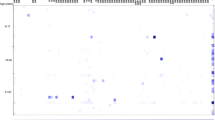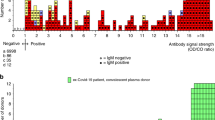Abstract
A major controversy regarding Kaposi's sarcoma–associated herpesvirus (KSHV or HHV8)1,2 is whether or not it is a ubiquitous infection of humans3,4. Immunoassays based on KSHV– and Epstein–Barr virus (EBV)–coinfected cell lines show that most US AIDS–KS patients have specific antibodies to KSHV–related antigens2,5,6. We have developed a sensitive indirect immunofluorescence assay (IFA) based on an EBV–negative, KSHV–infected cell line, BCP–1. When we used this IFA assay, KSHV–related antibodies were found in 71–88% of serum samples from US, Italian and Ugandan AIDS–KS patients, as well as all serum samples examined from HIV–seronegative KS patients. Although none of the US blood donors examined were KSHV seropositive by IFA, intermediate and high seroprevalence rates were found in Italian and Ugandan control populations. Antibody kinetics showed that more than half of the AIDS–KS patients who were examined IgG–seroconverted before KS development, and antibody levels did not decline after seroconversion. For these patients, seropositivity rates increased linearly with time, suggesting that the rate of infection was constant and that the risk of developing KS once infected with KSHV is not highly dependent on the duration of infection. These data strongly suggest that KSHV is not ubiquitous in most populations and that the virus may be under strict immunologic control in healthy KSHV–infected persons.
This is a preview of subscription content, access via your institution
Access options
Subscribe to this journal
Receive 12 print issues and online access
$209.00 per year
only $17.42 per issue
Buy this article
- Purchase on Springer Link
- Instant access to full article PDF
Prices may be subject to local taxes which are calculated during checkout
Similar content being viewed by others
References
Chang, Y. et al. Identification of herpesvirus-like DNA sequences in AIDS-associated Kaposi's sarcoma. Science 265, 1865–1869 (1994).
Moore, P.S. et al. Primary characterization of a herpesvirus-like agent associated with Kaposi's sarcoma. J. Virol. 70, 549–558 (1996).
Levy, J.A. A new human herpesvirus: KSHV or HHV8? Lancet 346, 786 (1995).
Weiss, R.A. Human herpesvirus 8 in lymphoma and Kaposi's sarcoma: Now the virus can be propagated. Nature Med. 2, 277–278 (1996).
Miller, G. et al. Antibodies to butyrate-inducible antigens of Kaposi's sarcoma-associated herpesvirus in patients with HIV-1 infection. N. Engl J. Med. 334, 1292–1297 (1996).
Gao, S.J. et al. Antibody response to latent Kaposi's sarcoma-associated herpesvirus-related antigens prior to onset of Kaposi's sarcoma. N. Engl. J. Med. 335, 233–241 (1996).
Cesarman, E. et al. In vitro establishment and characterization of two AIDS-related lymphoma cell lines containing Kaposi's sarcoma-associated herpesvirus-like (KSHV) DNA sequences. Blood 86, 2708–2714 (1995).
Gaidano, G. et al. Establishment of AIDS-related lymphoma cell lines from lymphomatous effusions. Leukemia (in the press).
Renne, R. et al. Lytic growth of Kaposi's sarcoma-associated herpesvirus (human herpesvirus 8) in culture. Nature Med. 2, 342–346 (1996).
Geddes, M. et al. Kaposi's sarcoma in Italy before and after the AIDS epidemic. Br. J. Cancer 69, 333–336 (1994).
Wabinga, H.R., Parkin, D.M. & Wabwire-Mangen, F.J.M. Cancer in Kampala, Uganda, in 1989–91: Changes in incidence in the era of AIDS. Int. J. Cancer 54, 5–22 (1993).
Monini, P. et al. Kaposi's sarcoma-associated herpesvirus DNA sequences in prostate tissue and human semen. N. Engl. J. Med. 334, 1168–1172 (1996).
Chang, Y. et al. Kaposi's sarcoma-associated herpesvirus DNA sequences are present in African endemic and AIDS-associated Kaposi's sarcoma. Arch. Intern. Med. 156, 202–204 (1996).
Nahmias, A.J., Lee, F.K., Beckman-Nahmias, S. Sero-epidemiological and sociological patterns of herpes simplex virus infection in the world. Scan. J. Infect. Dis. 69, 19–36 (1990).
Author information
Authors and Affiliations
Rights and permissions
About this article
Cite this article
Gao, SJ., Kingsley, L., Li, M. et al. KSHV antibodies among Americans, Italians and Ugandans with and without Kaposi's sarcoma. Nat Med 2, 925–928 (1996). https://doi.org/10.1038/nm0896-925
Received:
Accepted:
Issue Date:
DOI: https://doi.org/10.1038/nm0896-925
This article is cited by
-
Kaposi sarcoma (KS) with primary effusion lymphoma in HIV infected MSM (men having sex with men) co-infected with pulmonary tuberculosis and syphilis: a case report from India
AIDS Research and Therapy (2022)
-
KSHV (HHV8) vaccine: promises and potential pitfalls for a new anti-cancer vaccine
npj Vaccines (2022)
-
Navigating the heterogeneous landscape of pediatric Kaposi sarcoma
Cancer and Metastasis Reviews (2019)
-
Towards Better Understanding of KSHV Life Cycle: from Transcription and Posttranscriptional Regulations to Pathogenesis
Virologica Sinica (2019)
-
Was Kaposi’s sarcoma-associated herpesvirus introduced into China via the ancient Silk Road? An evolutionary perspective
Archives of Virology (2017)



